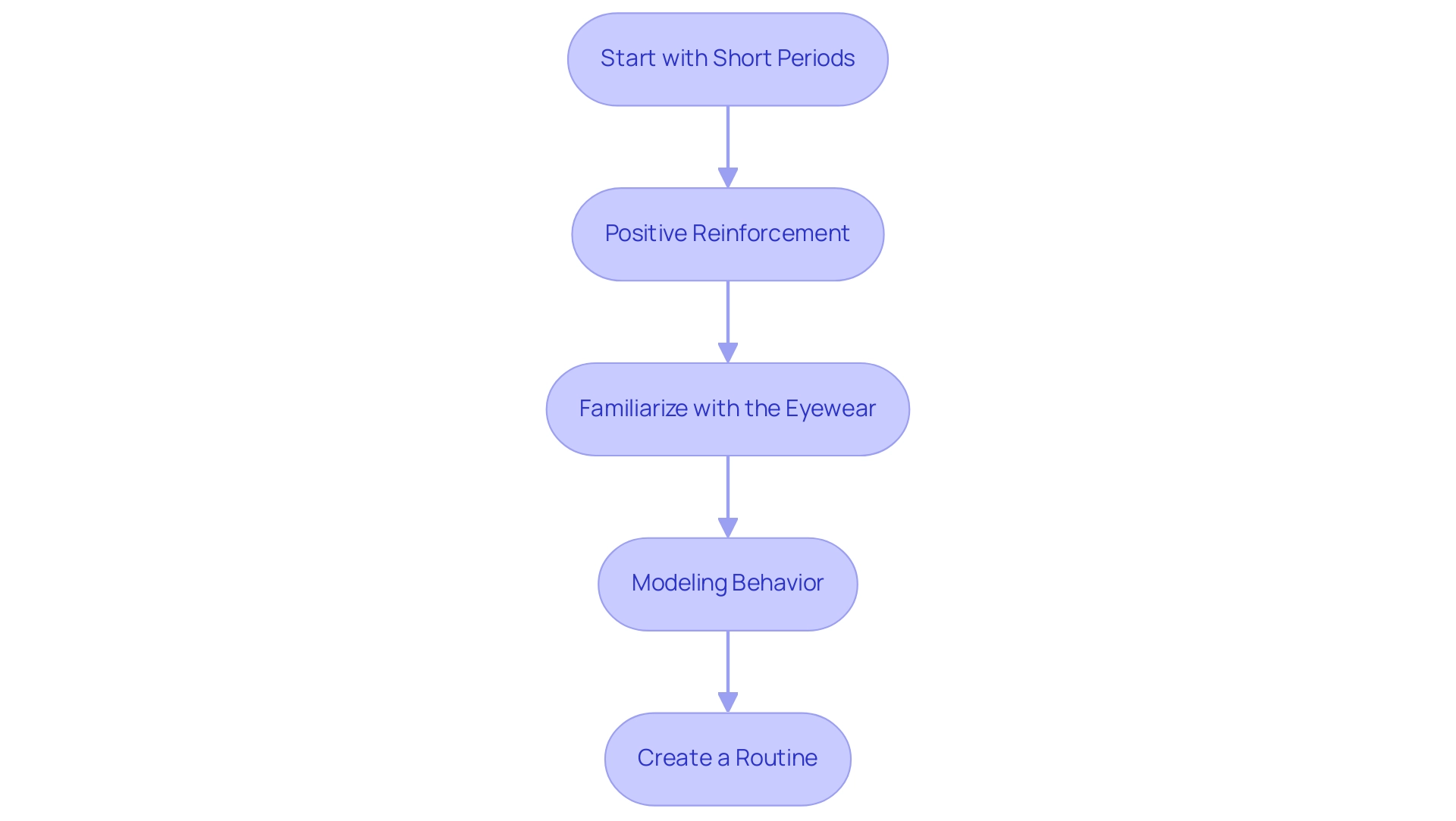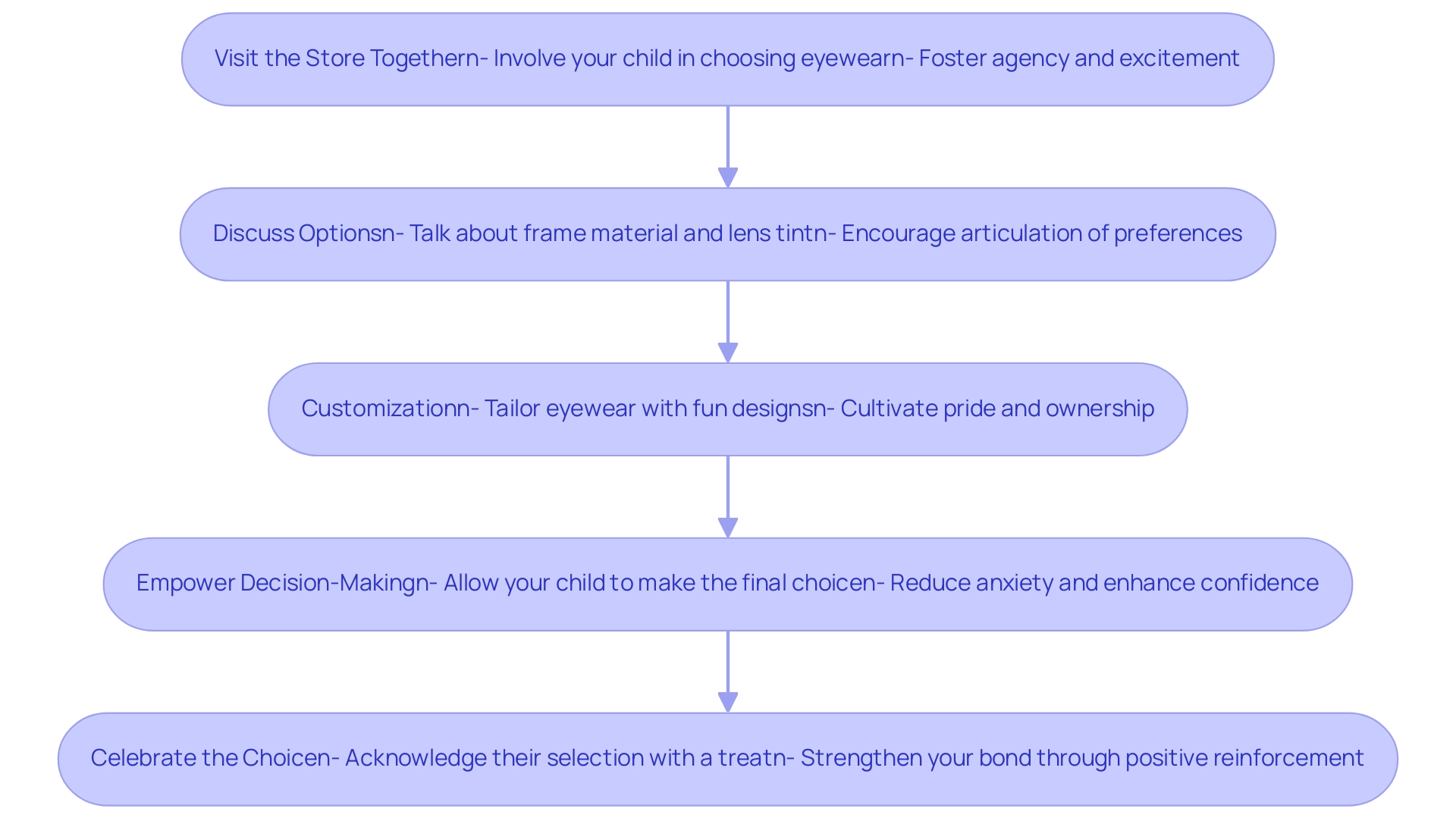Overview
To help your autistic child adjust to glasses, it is essential to recognize their heightened sensitivities and implement gradual, supportive strategies that foster comfort and acceptance. The article outlines effective methods such as starting with short wearing periods, using positive reinforcement, involving the child in choosing their eyewear, and creating a routine, all aimed at easing the transition and promoting a positive association with wearing glasses.
Introduction
Navigating the world of eyewear can be a complex journey, especially for autistic children who may face unique sensory sensitivities. The prospect of introducing glasses often comes with a myriad of challenges, from discomfort with the frames to emotional reactions stemming from unfamiliarity. Understanding these hurdles is essential for parents and caregivers who wish to support their children effectively.
By employing thoughtful strategies and fostering a sense of agency, families can transform the experience of wearing glasses into a positive milestone. This article delves into the challenges faced by autistic children in adapting to glasses, while also offering practical approaches to ensure a smoother transition, empowering both parents and children in this important aspect of vision health.
Understanding the Challenges of Introducing Glasses to Autistic Children
An autistic kid with glasses often faces heightened sensitivities that can make the experience of using eyewear uncomfortable or even distressing. With research indicating that 62.5% of children without eating or drinking issues display perceptual traits, it is crucial to acknowledge the potential discomfort these children might feel. They may perceive the pressure of the frames against their face, the weight of the lenses, or the unfamiliar visual changes that accompany new eyewear.
This adjustment can trigger significant emotional responses, including anxiety or frustration, particularly for an autistic kid with glasses, especially if past experiences with eyewear have been negative. As Baranek states,
the significance of creating direct observation measures to identify modulation disorder
emphasizes the necessity to comprehend how these sensitivities manifest. Creating these measures can offer insights into the specific challenges faced by an autistic kid with glasses, allowing parents and caregivers to customize their approach to introducing eyewear more effectively.
Furthermore, future research should explore the relationship between attention measures and sensory reactivity in youth with ASD and SMD, as understanding this connection is vital for addressing sensory sensitivities comprehensively. By recognizing these challenges, parents are empowered to approach the introduction of eyewear for their autistic kid with glasses with empathy and patience. Establishing a nurturing atmosphere can promote an easier adjustment for an autistic kid with glasses, enabling them to acclimate more comfortably to their new eyewear.
Recent studies, including longitudinal research on sensory features, highlight how these sensitivities can evolve over time, emphasizing the importance of monitoring comfort levels in an autistic kid with glasses. This understanding paves the way for healthier emotional responses and improved acceptance.
Effective Strategies for a Smooth Transition to Glasses
- Start with Short Periods: Initiating the journey of wearing spectacles can be made easier by introducing them for short intervals in familiar settings. This gradual approach allows your offspring to adapt at their own pace, increasing the duration as they grow more comfortable. Studies show that glasses will help children see movies clearer and read books easier, making this transition even more beneficial.
- Positive Reinforcement: Celebrating each successful usage session is crucial. Utilize praise, small rewards, or a sticker chart to reinforce positive behavior. This method not only fosters a sense of achievement but also builds a lasting, positive association with wearing glasses.
- Familiarize with the eyewear: Encourage your offspring to interact with the spectacles before they actually put them on. Allow them to touch the frames, examine the lenses, and even try them on without placing them on their face. This familiarity can significantly reduce anxiety and promote acceptance.
- Modeling Behavior: Children often learn by observing adults. If you or other family members use spectacles, showcase this behavior. Normalizing the experience by having someone they admire use eyewear can help your young one feel more at ease and less alone in their situation.
- Create a Routine: Establishing a routine around wearing spectacles can reinforce their importance. As highlighted in recent case studies, such as the one titled 'Develop a Fun Routine,' establishing a daily routine that involves caring for eyeglasses assists youngsters in incorporating them into their lives. Incorporate this step into daily activities, such as before meals or during specific playtime rituals. By assigning a specific time for eyewear, you assist your offspring in comprehending its role in daily life, promoting attachment and accountability. As Nick Davis said, 'Great service and friendly staff' can also make a significant difference in this process, emphasizing the importance of support during this transition.

Empowering Your Child: Involving Them in Choosing Their Glasses
- Visit the Store Together: Include your young autistic kid with glasses in the process of choosing eyewear by taking them along to the shop. Allow the autistic kid with glasses the opportunity to try on various styles and colors, making the experience interactive and enjoyable. This participation fosters a sense of agency and excitement for the autistic kid with glasses.
- Discuss Options: Engage in a conversation about the different features of the eyewear, such as frame material and lens tint. Encourage your offspring to articulate their preferences and dislikes, helping them feel valued in the decision-making process. This dialogue not only empowers them but also enhances their understanding of the choices available.
- Customization: Tailoring the eyewear can significantly impact how your kid feels about wearing them. Consider customizing frames with fun designs or colors that resonate with their interests, whether it be their favorite cartoon character or a vibrant color palette. This connection can cultivate a sense of pride and ownership over their eyewear. Studies show that youngsters who experience a personal bond with their eyewear are more inclined to don them with assurance.
- Empower Decision-Making: Grant your offspring, especially your autistic kid with glasses, the autonomy to make the final choice on which eyewear they prefer. This empowerment can significantly reduce any anxiety or resistance that an autistic kid with glasses may feel towards wearing eyewear, as they have actively chosen a style they love. It's also essential to consider that young people's social dynamics can be influenced by their eyewear choices; studies show that ethnicity does not affect young people's preferences for peers with or without spectacles, suggesting that inclusivity should be fostered regardless of appearance.
- Celebrate the Choice: Once your young one has made their selection, celebrate this achievement! A small treat or an outing can enhance their positive experience, making them more enthusiastic about using their new eyewear. This celebration not only acknowledges their choice but also strengthens your bond as they navigate this new chapter together.
Research shows that 12% of young individuals adjust to using eyewear in under one day, highlighting the significance of ensuring this shift is as seamless and pleasurable as possible. Additionally, studies show that spectacles can influence perceptions of intelligence among peers, as noted by experts who state,
In summary, this study found that spectacles make young individuals appear to be smarter to their peers, but they do not change their attitudes about shyness, honesty, attractiveness, athleticism, or whether or not they would play with them.
Furthermore, attention issues may arise when young individuals are selecting their glasses, as noted in the case study titled 'Influence of Attention on Study Outcomes,' which highlights how those aged 6 to 10 may struggle with focus when presented with choices.
Involving children in their eyewear choices cultivates confidence and can lead to positive social interactions, making it a crucial step for parents advocating for their child's vision health.

Conclusion
Introducing glasses to autistic children presents unique challenges, primarily due to sensory sensitivities that can make the experience uncomfortable or even distressing. Recognizing the emotional responses and discomfort that may arise is crucial for parents and caregivers. By understanding these challenges, families can create a supportive environment that fosters patience and empathy, allowing children to adapt more comfortably to their new eyewear.
Implementing effective strategies, such as:
- Starting with short wearing periods
- Using positive reinforcement
- Familiarizing children with glasses ahead of time
can significantly ease the transition. Encouraging involvement in the selection process and personalizing their glasses can empower children, instilling a sense of agency and pride in their new accessory. Celebrating their choices and integrating glasses into daily routines further solidifies their acceptance and importance in their lives.
Ultimately, guiding autistic children through the process of wearing glasses transforms what could be a daunting experience into a positive milestone. By employing thoughtful strategies and fostering an environment of support, parents can help their children navigate this journey with confidence and ease, ensuring that vision health becomes an integral and enjoyable part of their lives.
Frequently Asked Questions
What challenges do autistic kids with glasses face when using eyewear?
Autistic kids with glasses often experience heightened sensitivities that can make wearing eyewear uncomfortable or distressing. They may feel the pressure of the frames, the weight of the lenses, or notice unfamiliar visual changes when they start using glasses.
How can past experiences with eyewear affect an autistic child?
If an autistic child has had negative experiences with eyewear in the past, it can trigger significant emotional responses such as anxiety or frustration when they need to wear glasses again.
Why is it important to observe sensory sensitivities in autistic children?
Understanding sensory sensitivities is crucial as it helps identify modulation disorders. This knowledge allows parents and caregivers to tailor their approach when introducing eyewear, making the experience more manageable for the child.
What future research is suggested regarding autistic children and eyewear?
Future research should investigate the relationship between attention measures and sensory reactivity in youth with Autism Spectrum Disorder (ASD) and Sensory Modulation Disorder (SMD). This understanding is vital for addressing sensory sensitivities effectively.
How can parents help their autistic child adjust to wearing glasses?
Parents can approach the introduction of eyewear with empathy and patience, creating a nurturing environment that promotes easier adjustment for their autistic child.
What do recent studies indicate about sensory sensitivities in autistic children?
Recent longitudinal research highlights that sensory sensitivities can evolve over time, emphasizing the importance of monitoring comfort levels in autistic children with glasses to foster healthier emotional responses and improved acceptance of eyewear.




